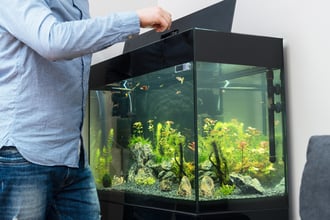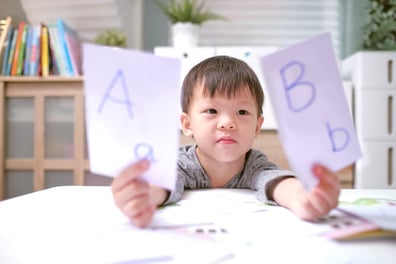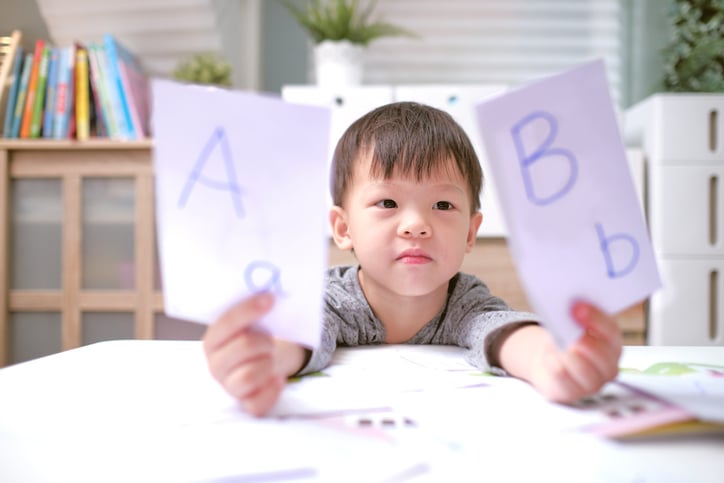Strategies for Teaching Autistic Children Letters
Autistic children can experience delays and challenges in learning letters, letter recognition, and writing letters. Writing and reading are powerful communication skills. Before your child begins to learn to read or write, they must first learn to recognize and identify letters. Teaching autistic children letter recognition is an essential step in their emergent literacy skills.
Teaching Autistic Children Letters
The ARIS® Academic Readiness Intervention System Language Builder curriculum developed by STAGES® Learning is an evidence-based curriculum based on the principles of ABA therapy and adapted for the classroom or homeschooling. The ARIS curriculum includes lessons that support your child in learning letters and pre-reading skills. You can use and adapt the ARIS lesson plans to supplement your child’s education.
Here are some easy ways to teach your child the basic skills of matching lowercase and uppercase letters, and receptively and expressively identifying letters.
Stages’ Language Builder: Sight Words & Phonics Cards are perfect for teaching your autistic child letters: These visually appealing real photo cards can be incorporated into fun games to help your child learn.
1. Matching Lowercase and Uppercase Letters:
Procedure:
- Find a spot to sit with your child. Make sure you have their attention.
- Place 1 letter card in front of the child.
- Hand the child the corresponding card and ask the student to match the cards.
- Give the instructions, “Match the letters,” “Put with same,” and “Put (a) with (a).”
- Wait for your child to find and match the letter correctly.
- Prompt if necessary.
- Wait for the student to match the letter cards correctly.
- Reinforce or correct the student as appropriate
2. Receptive Identification of Letters
Procedure:
- Find a spot to sit with your child. Make sure you have their attention.
- Place letter cards in front of the child.
- Give the instruction, “Give me (a),” “Touch (a),” “Find (a),” “Point to (a).”
- Wait for your child to select the correct letter.
- Prompt if necessary.
- Wait for the student to match the letter cards correctly.
- Reinforce or correct the student as appropriate
3. Expressive Identification of Letters
Procedure:
- Find a spot to sit with your child. Make sure you have their attention.
- Place the letter card on the table or hold it up in front of the child.
- Ask your child, “What letter is this?”
- Wait for your child to identify the letter.
- Prompt if necessary.
- Wait for the student to match the letter cards correctly.
- Reinforce or correct the student as appropriate
To see a complete ARIS lesson on learning letters you can download a free lesson:
Lesson 135: Print Awareness & Letter Knowledge: Matching—Upper Case Letters
Ideas for Generalizing Your Child’s Learning
Once your child can match and identify lowercase and uppercase letters, generalize their knowledge. This is an important step to reinforcing letter knowledge beyond just identifying letters on cards. Use handwritten flashcards to match, as they may look different to the student than printed letters. Write the letters in different colors, play a memory game with the letters, or match letter manipulatives (letter beads, foam letters, or wooden blocks). As your child progresses, have them match lowercase letters with uppercase letters.
Create a Personalized Alphabet Book for Kids
Make a personalized alphabet book for your child. It is motivating for children to see images of their family members, friends, favorite television characters, and preferred items.
Use your alphabet book like a scrapbook. Include 26 pages -- one page for each letter. Print pictures or search online. Choose a picture of a sibling or pick out an image of their favorite Frozen character to include. Collage, write, and interact with the pages! For example, for the “A” page, you might include a picture of an “Aunt,” their favorite food like “apple,” or their favorite Disney character “Aurora.”
 Be sure to write the name of the image underneath the picture, so your child knows “A” is for “Aunt,” “apple,” and “Aurora.” Using pictures of real people, places, and things is helpful because your child will begin to naturally recognize them in their environment. As your child begins to engage more with words and letters around them, encourage them to interact with their alphabet book and add new images and drawings. Include images of your child, as well! When you visit a new place, such as the “aquarium,” paste it into their book. Your child may become especially motivated and excited to talk about their adventures and things they’ve seen when adding to their Alphabet Book.
Be sure to write the name of the image underneath the picture, so your child knows “A” is for “Aunt,” “apple,” and “Aurora.” Using pictures of real people, places, and things is helpful because your child will begin to naturally recognize them in their environment. As your child begins to engage more with words and letters around them, encourage them to interact with their alphabet book and add new images and drawings. Include images of your child, as well! When you visit a new place, such as the “aquarium,” paste it into their book. Your child may become especially motivated and excited to talk about their adventures and things they’ve seen when adding to their Alphabet Book.
Strategies for Teaching Autistic Children
- Start with lowercase letters. If your child is just starting to match and identify letters, starting with lowercase letters is helpful. The majority of print we see every day is in lowercase letters.
- Incorporate music. Sing the alphabet song, “B-I-N-G-O,” or make up your own letter songs. As you sing, have your child point to the corresponding letters.
 Make it a game. Learning letters can be an overwhelming process. Turn letter matching into a memory game. Print letters on large printer paper, spread them across the floor, and have your child jump or skip to its match. Grab a magnifying glass and challenge your child to solve the ”mystery of the missing match.” Make learning letters interactive!
Make it a game. Learning letters can be an overwhelming process. Turn letter matching into a memory game. Print letters on large printer paper, spread them across the floor, and have your child jump or skip to its match. Grab a magnifying glass and challenge your child to solve the ”mystery of the missing match.” Make learning letters interactive!- Go on a letter hunt. Pick out your child’s favorite book or print a paper with some sentences about something they love. Hand them a marker and challenge them to find all the “a’s,” “b’s,” “c’s,” etc. Can they find the right letters?
- Use multisensory techniques. Matching letters on paper isn’t always engaging. Letter puzzles are a fun way to practice matching letters. Figuring out if the matching letter “fits” offers your child immediate feedback if it’s correct or not.
- Make an alphabet journal. If your child is crafty, find a stack of magazines and have them cut out letters they find! For example, start searching for “A’s” and cut and paste all the “A’s” they can find. For an extra challenge, have them sort the uppercase and lowercase letters.
Alphabet Poems to Sing Along to
Use poems and songs to engage your child with the letters they are learning. Songs besides the classic “alphabet song” can be a fun, silly way to practice letters. There are lots of online videos or books like “Chicka Chicka Boom Boom” to follow along with.
 “A is for Apple” sung to the tune of “B-I-N-G-O”
“A is for Apple” sung to the tune of “B-I-N-G-O”
There was a fruit and it was sweet,
A-P-P-L-E, A-P-P-L-E, A-P-P-L-E, and
Apple was its name-O.
“B Song” sung to the tune of Twinkle, Twinkle, Little Star
 Baby got a ball today,
Baby got a ball today,
Baby got a ball today.
Rode the bus and bounced the ball,
Rode the bus and bounced the ball.
Baby got a ball today,
Baby better bounce the ball.
Check out Stages Learning's “Alphabet Soup Sorters!” Each soup can contains 1 uppercase and 1 lowercase letter, plus 5 durable object cards with real-life photos on one side and the word on the other. This set of Alphabet Soup Sorters provides an entertaining way to develop literacy, vocabulary, and language skills. An activity guide is included, and this fun set of Soup Sorters is great for visual and tactile learners. Practice sorting photo cards into the correct soup can, putting the letters in order, or matching uppercase and lowercase letters. Let your child explore all the ways they can learn their letters using the Alphabet Soup Sorters.
Learning letters is the first step to independence in beginning to read and write. Knowing their letters will introduce a whole new world of communication to your autistic child. Practicing letter recognition can be done through multisensory techniques. Incorporating music, art, and movement into letter learning is important in keeping your autistic child engaged.
This article is based on the following research and resources:
Language Builder: Academic Readiness Intervention System (ARIS) curriculum https://www.howweelearn.com/teaching-letter-recognition-what-order-to-introduce-letters/
https://www.speciallearninghouse.com/5-awesome-ways-teach-special-needs-learners-letters/
https://accessibleaba.com/blog/reading-autism
http://littletotschildcare.ca/helping-children-autism-learn-alphabet-numbers/
https://www.thelearningapps.com/10-tips-to-teach-numbers-alphabets-to-children-with-autism/
https://blog.allaboutlearningpress.com/teach-reading-autistic-child/
https://misskindergarten.com/how-to-teach-the-alphabet/
https://www.growinghandsonkids.com/7-mistakes-avoid-teaching-alphabet-preschooler.html







